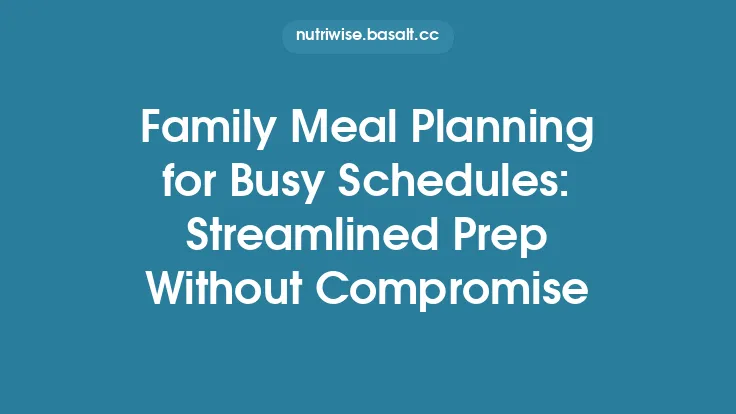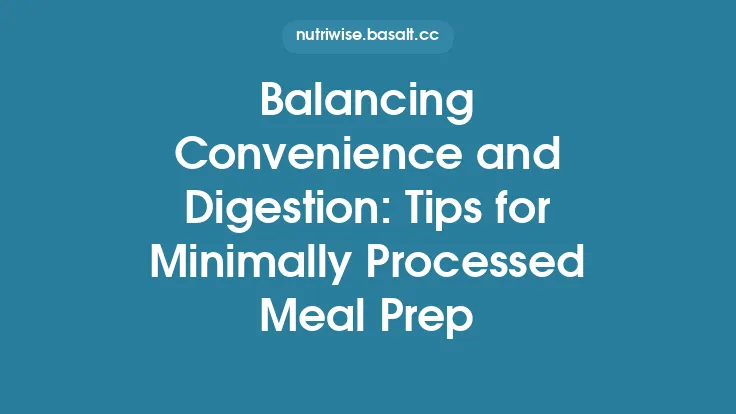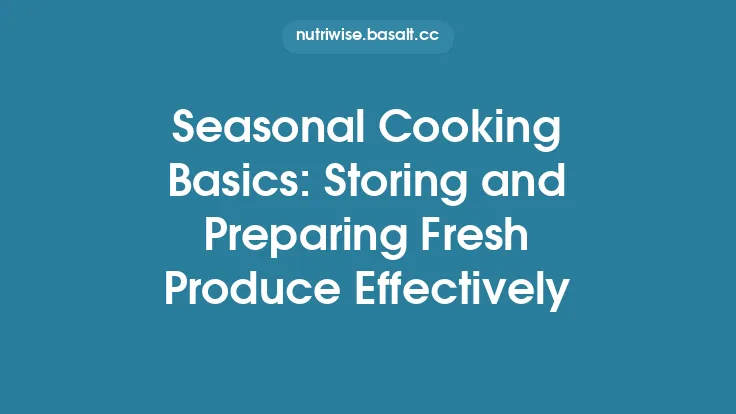Freezer‑friendly meal prep is more than just tossing cooked food into a bag and hoping for the best. When done thoughtfully, it can become a reliable way to keep nutritious, flavorful meals on hand for weeks or even months, without sacrificing the very qualities that make home‑cooked food appealing. Below is a comprehensive guide that walks you through the entire process—from selecting the right dishes to the final thaw‑and‑serve step—while focusing on preserving nutrients and flavor.
Choosing Recipes That Freeze Well
Not every dish is created equal when it comes to the freezer. Certain cooking methods and ingredient combinations naturally lend themselves to long‑term storage, while others can become mushy, lose color, or develop off‑flavors.
Key characteristics of freezer‑friendly recipes
| Characteristic | Why It Helps | Examples |
|---|---|---|
| High moisture content that can be reduced | Excess water forms large ice crystals that damage cell walls, leading to texture loss. Reducing moisture before freezing helps maintain structure. | Soups, stews, chili (skim excess broth), sautéed vegetables (pat dry). |
| Robust sauces or gravies | A well‑balanced sauce acts as a protective barrier, sealing in flavor and slowing oxidation. | Tomato‑based sauces, coconut‑curry bases, béchamel. |
| Proteins cooked to medium doneness | Over‑cooked meat becomes dry after thawing; cooking to a slightly lower internal temperature preserves juiciness. | Chicken breast cooked to 155 °F (68 °C) rather than 165 °F (74 °C). |
| Whole‑grain or legume bases that are pre‑cooked but not over‑softened | Grains that are al dente retain bite after reheating, preventing a mushy mouthfeel. | Brown rice, quinoa, lentils cooked to 80 % of final texture. |
| Seasonings added after freezing | Some herbs and spices lose potency in the freezer; adding them post‑thaw keeps flavors bright. | Fresh basil, cilantro, dill. |
When building a weekly menu, aim for a mix of dishes that meet these criteria. A balanced plan might include a hearty stew, a grain‑based bowl, a protein‑centric casserole, and a vegetable‑forward side.
Preparing Ingredients for the Freezer
The way you treat each component before it meets the cold can dramatically affect nutrient retention.
1. Blanching Vegetables
Blanching—briefly boiling vegetables followed by an ice‑water shock—serves two purposes: it inactivates enzymes that would otherwise cause color fading and nutrient degradation, and it sets the cellular structure, reducing the size of ice crystals that form later.
General blanching guide (adjust for size and type):
| Vegetable | Boil Time | Ice‑Water Shock |
|---|---|---|
| Green beans, peas | 2–3 min | 2 min |
| Broccoli florets | 3 min | 3 min |
| Carrots (sliced) | 4 min | 4 min |
| Spinach (whole leaves) | 30 s | 1 min |
After shocking, drain thoroughly and pat dry with a clean kitchen towel or a salad spinner. Excess water will become ice, contributing to freezer burn.
2. Pre‑Cooking Grains and Legumes
Cook grains and legumes to just shy of full doneness (about 80 % of the final texture). This “pre‑cooking” prevents them from becoming overly soft after a second heating cycle. Rinse cooked legumes in cold water to stop the cooking process and remove surface starch that can cause clumping.
3. Marinating Proteins
A brief marination (15–30 minutes) before cooking can infuse flavor and also act as a natural cryoprotectant. Acidic components (citrus juice, vinegar) and a modest amount of oil help maintain moisture during freezing. Avoid overly salty marinades, as salt can draw out water and increase the risk of freezer burn.
4. Cooling Before Freezing
Rapid cooling is essential to preserve nutrients. Spread cooked food in a thin layer on a baking sheet or use an ice‑water bath for soups and sauces. The goal is to bring the temperature down to below 70 °F (21 °C) within two hours. This step also minimizes the time enzymes have to act, even though they are largely inactivated by blanching.
Techniques to Minimize Nutrient Loss
Freezing itself is a gentle preservation method, but the steps surrounding it can cause oxidation, leaching, or heat‑induced degradation.
a. Use Antioxidant‑Rich Additions
Incorporate natural antioxidants that protect vitamins during the freeze‑thaw cycle:
- Lemon or lime juice (vitamin C) for brightening sauces.
- Fresh herbs like rosemary or thyme, which contain phenolic compounds.
- A small amount of oil (olive, avocado) to create a barrier against oxidation.
b. Control pH
A slightly acidic environment (pH 5.5–6.5) slows enzymatic activity and preserves color, especially in vegetables like carrots and potatoes. Adding a teaspoon of vinegar or a splash of citrus juice to the cooking water can achieve this without altering taste dramatically.
c. Avoid Over‑Processing
Pureeing foods before freezing can expose more surface area to oxygen, accelerating nutrient loss. If a puree is required (e.g., for a soup), consider freezing it in smaller portions to limit exposure.
d. Freeze Quickly
The faster the food passes through the temperature “danger zone” (32–40 °F / 0–4 °C), the smaller the ice crystals that form. Smaller crystals cause less mechanical damage to cell walls, preserving texture and nutrient integrity.
Flavor‑Retention Strategies
Flavor is a delicate balance of volatile compounds, fats, and aromatic molecules—all of which can be altered by freezing. Below are proven methods to lock in taste.
1. Layering Flavors
Build flavor in stages:
- Base: aromatics (onion, garlic, ginger) sautéed before freezing.
- Mid‑point: herbs and spices added during cooking.
- Finish: fresh herbs, a squeeze of citrus, or a drizzle of flavored oil added after thawing.
This approach ensures that the most volatile components (fresh herbs, citrus) remain bright.
2. Use Fat Wisely
Fats act as carriers for flavor compounds. Incorporating a modest amount of butter, coconut milk, or olive oil into sauces before freezing helps preserve aromatic molecules. However, avoid excessive fat, which can separate upon thawing.
3. Salt Timing
Salt can draw moisture out of foods, increasing the risk of freezer burn. Lightly season during cooking, then adjust after thawing if needed. This also prevents over‑salting, which can become more pronounced after the concentration effect of water loss.
4. Incorporate Umami Boosters
Ingredients like miso, soy sauce, nutritional yeast, or a splash of Worcestershire sauce add depth that survives freezing well. Add them toward the end of cooking to preserve their nuanced flavors.
Packaging Practices to Prevent Ice Crystals
Even with perfect preparation, the packaging is the final line of defense against freezer burn and flavor loss.
a. Choose the Right Barrier
- Freezer‑grade polyethylene bags: thin, flexible, and provide a good moisture barrier when air is expelled.
- Rigid containers with tight‑fitting lids: useful for soups and stews; ensure the lid is sealed before the food expands.
b. Remove Excess Air
Air is the primary culprit behind freezer burn. Press out as much air as possible from bags before sealing. For containers, leave a small headspace (about ½ inch) to accommodate expansion, then press the lid down firmly.
c. Double‑Layer for Sensitive Items
For foods prone to dehydration (e.g., sliced fruit, delicate sauces), wrap the portion in a layer of parchment paper before placing it in a bag. This extra barrier reduces direct exposure to the freezer environment.
d. Portion Control Without Over‑Portioning
Divide meals into single‑serve or family‑size portions based on your typical consumption patterns. This avoids repeated thaw‑refreeze cycles, which degrade both nutrients and flavor.
Rapid Freezing and Storage Tips
The speed at which food freezes determines crystal size and, consequently, texture quality.
1. Use a “Flash Freeze” Method
- Spread items (e.g., berries, diced vegetables) on a baking sheet in a single layer.
- Freeze uncovered for 1–2 hours until solid.
- Transfer to a sealed bag or container.
This prevents clumping and ensures each piece freezes independently.
2. Keep the Freezer Full, But Not Overcrowded
A well‑stocked freezer maintains a stable temperature, which aids rapid freezing. However, overcrowding impedes air circulation, slowing the process. Arrange items so that cold air can flow around each package.
3. Label with a Simple System (Without Going Into Full Labeling Practices)
Even though detailed labeling is covered elsewhere, a quick visual cue—such as a colored sticker or a brief handwritten note—helps you locate meals quickly, reducing the time the freezer door stays open.
Thawing Methods That Protect Quality
Proper thawing is as important as freezing. The goal is to bring the food back to a temperature where texture and nutrients remain intact, without encouraging bacterial growth (which is covered in safety guides).
a. Refrigerator Thaw
Place the frozen package on a low shelf in the refrigerator and allow it to thaw slowly (typically 12–24 hours, depending on size). This gradual rise in temperature minimizes moisture loss and preserves the integrity of delicate flavors.
b. Cold‑Water Bath (For Smaller Portions)
Seal the food in a watertight bag, submerge it in cold water, and change the water every 30 minutes. This method thaws food more quickly than the refrigerator while still keeping the temperature low enough to protect nutrients.
c. Direct Cooking from Frozen (When Appropriate)
Certain dishes—like soups, stews, or casseroles—can be cooked directly from frozen. Adding a few extra minutes to the cooking time ensures even heating and reduces the risk of over‑cooking once thawed.
Re‑customizing Meals After Thawing
Even the best‑planned freezer meals can benefit from a final touch to bring them back to life.
1. Fresh Herb Finish
Add a handful of chopped fresh herbs (parsley, cilantro, basil) just before serving. This restores brightness that may have dulled during storage.
2. Adjust Seasonings
Taste the reheated dish and finish with a pinch of salt, a splash of acid (lemon juice, vinegar), or a drizzle of high‑quality oil. Small adjustments can dramatically enhance flavor perception.
3. Texture Boosters
For dishes that have become slightly soft (e.g., sautéed vegetables), a quick sauté in a hot pan with a little oil can restore a pleasant bite. This step also adds a fresh layer of Maillard flavor.
Common Pitfalls and How to Avoid Them
| Pitfall | Why It Happens | Prevention |
|---|---|---|
| Ice crystals forming on the surface | Slow freezing or excess air in packaging | Use flash‑freeze technique and squeeze out air |
| Mushy texture after thawing | Over‑cooking before freezing or using overly soft grains | Cook proteins to slightly under‑done, keep grains al dente |
| Flavor dullness | Loss of volatile aromatics during storage | Add fresh herbs, citrus, or a splash of oil after thawing |
| Nutrient degradation | Prolonged exposure to heat before freezing | Cool quickly, blanch vegetables, use antioxidant additions |
| Freezer burn | Air exposure and moisture loss | Use airtight, freezer‑grade packaging; double‑wrap delicate items |
Putting It All Together: A Sample Freezer‑Friendly Meal Prep Workflow
- Menu Planning
- Choose 3–4 dishes that meet the freezer‑friendly criteria (e.g., a chicken‑vegetable curry, a quinoa‑black bean bowl, a roasted vegetable lasagna).
- Ingredient Prep
- Blanch broccoli and carrots (2 min and 4 min respectively).
- Cook quinoa to 80 % doneness, rinse, and cool.
- Marinate chicken pieces in olive oil, lemon juice, and herbs for 20 min.
- Cooking
- Sauté aromatics (onion, garlic, ginger).
- Add spices, then protein; cook to slightly under‑done.
- Incorporate vegetables and quinoa; finish with a modest amount of coconut milk for richness.
- Cooling
- Spread the curry on a shallow tray; stir occasionally to release heat.
- Transfer to an ice‑water bath for soups; use a fan to speed cooling for solid dishes.
- Portioning & Packaging
- For individual servings, spoon 1‑cup portions onto parchment‑lined trays; flash freeze for 1 hour.
- Transfer frozen portions into freezer‑grade bags, removing as much air as possible.
- Label with a colored sticker indicating “Curry – Week 1”.
- Storage
- Place bags in a single layer on a freezer shelf; keep the door closed for at least 4 hours to ensure rapid freeze.
- Thaw & Serve
- Move a bag to the refrigerator the night before.
- Reheat gently on the stovetop, adding a splash of coconut milk and fresh cilantro just before serving.
By following this systematic approach, you’ll consistently produce freezer‑stored meals that retain the bright colors, crisp textures, and nutrient density of freshly cooked food—making healthy eating both convenient and enjoyable.





